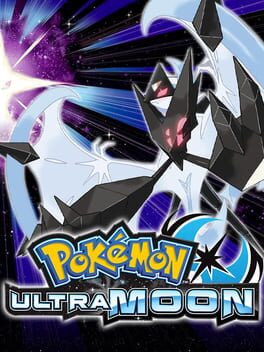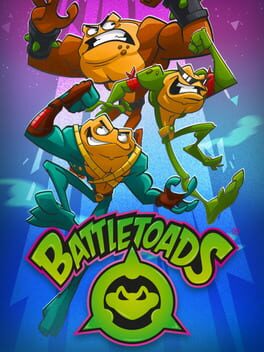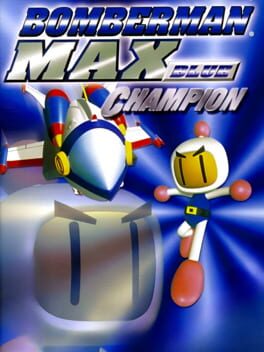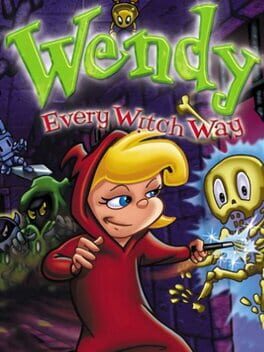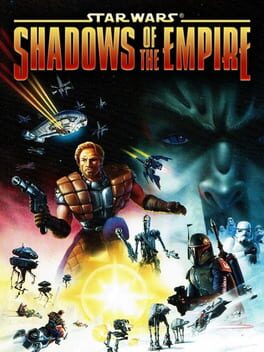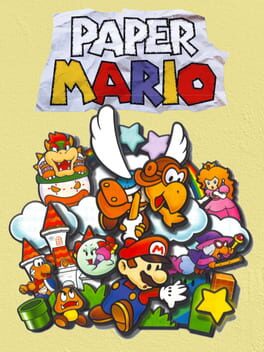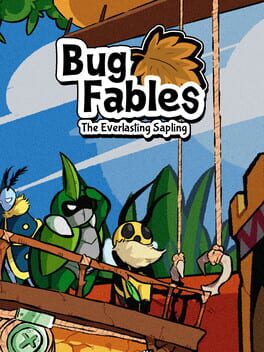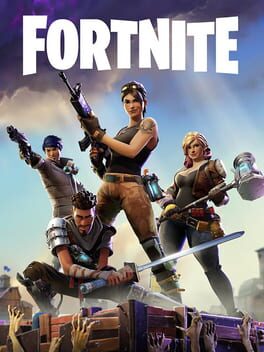DustStar6
2017
This feels like it should have been a $10 DLC add on to Sun/Moon rather than a full priced game. Even compared to some of pokemon's other "third versions" and especially compared to the Black/White sequels which the marketing kept on comparing this to, this feels especially lazy and pointless.
Players who have played the originals are better of sticking with them while people who haven't are still better off playing the original Sun/Moon as these newer titles do not add much to justify them and the changes to the games story are so awkward and poorly thought out that they end up making the overall story worse.
Players who have played the originals are better of sticking with them while people who haven't are still better off playing the original Sun/Moon as these newer titles do not add much to justify them and the changes to the games story are so awkward and poorly thought out that they end up making the overall story worse.
2023
Everything a remake should be, and then some. The original Super Mario RPG on Super Nintendo was an influential title which directly inspired two other Mario RPG series from it and countless indie titles inspired by all three. This remake provides an excellent way for old fans and newcomers to experience the classic title in all it's glory.
The 3D models perfectly convey the charm and style of the SNES original's sprite art. The soundtrack consists of a series of excellent arrangements all lovingly done by the original game's composer, the legendary Yoko Shimomura. Pretty much every minute detail of the game was dedicated to modernizing the title while making all of it perfectly recognizable to fans of the original.
If you're looking to try Mario's first crack at a Role Playing Game, this game should definitely be on your list.
The 3D models perfectly convey the charm and style of the SNES original's sprite art. The soundtrack consists of a series of excellent arrangements all lovingly done by the original game's composer, the legendary Yoko Shimomura. Pretty much every minute detail of the game was dedicated to modernizing the title while making all of it perfectly recognizable to fans of the original.
If you're looking to try Mario's first crack at a Role Playing Game, this game should definitely be on your list.
1999
The original Snowboard Kids was a game that everyone I knew with an N64 seemed to have. Its catchy music, cute and stylized character designs, and “Mario Kart on a snowboard” style gameplay made it one of the N64's most notable cult classics. So I was surprised how few people were aware that it received a sequel (two actually, but the less said about the DS game the better). Though a bit slower paced than its predecessor, Snowboard Kids 2 still excels in the places where the original did, and in many places surpasses it.
The game retains the stylized look of the original. While it might not look as great as some of its contemporaries, its cute and stylish design definitely helped its visuals stand the test of time. Players are treated to a ton of crazy, diverse and imaginative environments for the big nosed playable characters to challenge the idea of where you should and shouldn't try to snowboard through, from sandy beaches, to a giant bedroom, to outer space. Accompanying these wild settings is a fun and bouncy soundtrack that you'll be humming along to right away.
Most of the items from the first game return, some of which are buffed or adjusted like the glove now causing opponents to drop money. On top of that, several new weapons and items are introduced in this game like the rocket and the wings. The trick system was also reworked with a new, more simplified system which removes character specific tricks, but now allows characters to perform multiple tricks in a single jump encouraging players to chain together their own combination of flips and grabs to earn increasing coin rewards.
The computer difficulty was also tweaked from the original with the AI being toned down for the normal mode. Though it returns in full force in expert mode insane item luck and apparent omniscience. Snowboard Kids 2 also adds in bosses which can range from reasonably challenging to aggressively frustrating.
Overall, Snowboard Kids 2 feels like a full upgrade over it's predecessor. With tighter controls, more tracks and characters, and a difficulty curve that is easier to get into but just as hard to master, the game is a must play for fans of the first title.
The game retains the stylized look of the original. While it might not look as great as some of its contemporaries, its cute and stylish design definitely helped its visuals stand the test of time. Players are treated to a ton of crazy, diverse and imaginative environments for the big nosed playable characters to challenge the idea of where you should and shouldn't try to snowboard through, from sandy beaches, to a giant bedroom, to outer space. Accompanying these wild settings is a fun and bouncy soundtrack that you'll be humming along to right away.
Most of the items from the first game return, some of which are buffed or adjusted like the glove now causing opponents to drop money. On top of that, several new weapons and items are introduced in this game like the rocket and the wings. The trick system was also reworked with a new, more simplified system which removes character specific tricks, but now allows characters to perform multiple tricks in a single jump encouraging players to chain together their own combination of flips and grabs to earn increasing coin rewards.
The computer difficulty was also tweaked from the original with the AI being toned down for the normal mode. Though it returns in full force in expert mode insane item luck and apparent omniscience. Snowboard Kids 2 also adds in bosses which can range from reasonably challenging to aggressively frustrating.
Overall, Snowboard Kids 2 feels like a full upgrade over it's predecessor. With tighter controls, more tracks and characters, and a difficulty curve that is easier to get into but just as hard to master, the game is a must play for fans of the first title.
2020
Battletoads is a series with a rather interesting and unique legacy. The original game on the NES was famous for its incredible visuals and varied gameplay and infamous for its intense difficulty which ranged from tough as nails, but mostly fair, to something clearly designed by a sadist for the purpose of breaking the player. Making a follow up to a game like this is guaranteed to be divisive no matter what direction you go in. You'll have fans demanding that you retain the insane difficulty at all costs, and how the unfair game design is the point of the series. You'll have fans who want a challenge, but want the difficulty to arise from a more fair style of game design. And then you'll have some people who just want the game to be more accessible to people who don't want to dedicate years of their lives to trying to clear the third level of a game. It's naturally impossible to please everyone, but trying to make as many people happy as possible is no easy feat either. There's a reason you don't see as many people talking about Battlemaniacs or the excellent Battletoads Arcade game. Battletoads (2020) chose to mostly focus on the second crowd I listed earlier, trying to craft a game that is tough as nails, but with challenges that are more comparable to the best levels of the original game rather than the cheaper ones like Surf's Up.
The game offers the player 3 difficulty options ranging from Tadpole, the game's easy mode which lets newer or less experienced players dip their toes into the world of Battletoads, Toad, the normal difficulty which provides a brisk and engaging challenge to most players, and Battletoad, the hard mode which evokes the original's brutal reputation. Each difficulty is well suited and balanced for their intended audiences with Tadpole being simple enough to breeze through in about 6 or 7 hours while the Battletoad difficulty takes the average player roughly 15 hours to grind through. Most of the game's difficulty is fair to the player, making the challenges hard, yet do-able with some practice. Levels will often give players a chance to learn about and adjust to whatever gimmick it revolves around before really forcing them to master it to get through the level.
Like most of the prior Battletoads games, gameplay is a mixed bag of various genres and styles that vary from level to level including the jet bike/sled races, puzzle platforming, shoot-em-ups, timing based mini-games, and of course the main beat-em-up sections. Each toad controls slightly different, enough to give each character a unique feel. Pimple is slower but hits a lot harder, Zits is speedier with a great combo game, and Rash is somewhere inbetween. Each character is designed to fit a preferred playstyle while never feeling like a chore to use if you preferred using a different toad. Some parts of the game were clearly designed with 3 player co-op in mind. While the game's design and mechanics usually do plenty to compensate for having just one or 2 players, it still becomes very noticeable. But this detail does draws attention to the game's single biggest flaw: it's baffling lack of online co-op, instead opting to focus on just local couch co-op. There are also a few stages that do get frustrating such as some of the later shoot-em-up stages which rapidly evolve into bullet hell, and especially Emergency Stations, a mini-game focused level which has so much stuff on the screen that it becomes very difficult just to tell what you're supposed to be doing most of the time. But these aside, the game shows that you don't have to be sadistic and frustrating to provide players with an engaging challenge.
As for the presentation, the Battletoads 2020 does a few things wrong, but a lot more things right. The game has a fun, colorful art style with creative character designs, wildly absurd animations, and some funny if sometimes intentionally cheesy dialogue that makes it feel like you're in the middle of an old Saturday morning cartoon. Though not everything about it is perfect. The standout example for the fans is the Dark Queen's redesign. While some fans immediately complained at they intentionally taking away the sex appeal of her old design, I feel the bigger problem is just how boring her new look is. And speaking of villains the game's new antagonists, the Topians, are dull and uninteresting additions with okayish designs, and completely uninteresting and unfunny personalities. The writing and humor itself can be hit/miss as a lot of the meta humor surrounding the Battletoads as irrelevant, washed up relics of the 90s completely fails to hit the mark The attempts at self aware humor at the ridiculousness of the Battletoads universe also fails to hit the mark, especially with how jarring it is after the Toads' recent appearances in other games where their absurdity is played completely straight and serious. But the best part about these drawbacks is that the bland and unfunny bits are really brief in comparison to the genuinely funny humor the game has to offer. The game's writing and story does a great job at fleshing out each toad as a unique and funny character with his own quirks and personality. Likewise, I also liked how the Dark Queen was fleshed out as a character, being cunning and manipulative, but also not quite so above the quirky heroes as she'd like to imagine she is. When the writing isn't making jokes at the expense of the series or focusing on the Topians, it mostly produces gold. On top of all of this we have the game's soundtrack which is phenomenal. The music is mostly rock songs including both original tracks and arrangements of iconic songs from previous Battletoads games, including the original, Battlemaniacs, and most surprisingly even draws from the Double Dragon crossover. Each track perfectly conveys the mood and tone of the game and the setting they are used in.
Overall Battletoads (2020) is a humorous, fun and challenging experience that fans of the series and the beat-em-up genre should not miss.
The game offers the player 3 difficulty options ranging from Tadpole, the game's easy mode which lets newer or less experienced players dip their toes into the world of Battletoads, Toad, the normal difficulty which provides a brisk and engaging challenge to most players, and Battletoad, the hard mode which evokes the original's brutal reputation. Each difficulty is well suited and balanced for their intended audiences with Tadpole being simple enough to breeze through in about 6 or 7 hours while the Battletoad difficulty takes the average player roughly 15 hours to grind through. Most of the game's difficulty is fair to the player, making the challenges hard, yet do-able with some practice. Levels will often give players a chance to learn about and adjust to whatever gimmick it revolves around before really forcing them to master it to get through the level.
Like most of the prior Battletoads games, gameplay is a mixed bag of various genres and styles that vary from level to level including the jet bike/sled races, puzzle platforming, shoot-em-ups, timing based mini-games, and of course the main beat-em-up sections. Each toad controls slightly different, enough to give each character a unique feel. Pimple is slower but hits a lot harder, Zits is speedier with a great combo game, and Rash is somewhere inbetween. Each character is designed to fit a preferred playstyle while never feeling like a chore to use if you preferred using a different toad. Some parts of the game were clearly designed with 3 player co-op in mind. While the game's design and mechanics usually do plenty to compensate for having just one or 2 players, it still becomes very noticeable. But this detail does draws attention to the game's single biggest flaw: it's baffling lack of online co-op, instead opting to focus on just local couch co-op. There are also a few stages that do get frustrating such as some of the later shoot-em-up stages which rapidly evolve into bullet hell, and especially Emergency Stations, a mini-game focused level which has so much stuff on the screen that it becomes very difficult just to tell what you're supposed to be doing most of the time. But these aside, the game shows that you don't have to be sadistic and frustrating to provide players with an engaging challenge.
As for the presentation, the Battletoads 2020 does a few things wrong, but a lot more things right. The game has a fun, colorful art style with creative character designs, wildly absurd animations, and some funny if sometimes intentionally cheesy dialogue that makes it feel like you're in the middle of an old Saturday morning cartoon. Though not everything about it is perfect. The standout example for the fans is the Dark Queen's redesign. While some fans immediately complained at they intentionally taking away the sex appeal of her old design, I feel the bigger problem is just how boring her new look is. And speaking of villains the game's new antagonists, the Topians, are dull and uninteresting additions with okayish designs, and completely uninteresting and unfunny personalities. The writing and humor itself can be hit/miss as a lot of the meta humor surrounding the Battletoads as irrelevant, washed up relics of the 90s completely fails to hit the mark The attempts at self aware humor at the ridiculousness of the Battletoads universe also fails to hit the mark, especially with how jarring it is after the Toads' recent appearances in other games where their absurdity is played completely straight and serious. But the best part about these drawbacks is that the bland and unfunny bits are really brief in comparison to the genuinely funny humor the game has to offer. The game's writing and story does a great job at fleshing out each toad as a unique and funny character with his own quirks and personality. Likewise, I also liked how the Dark Queen was fleshed out as a character, being cunning and manipulative, but also not quite so above the quirky heroes as she'd like to imagine she is. When the writing isn't making jokes at the expense of the series or focusing on the Topians, it mostly produces gold. On top of all of this we have the game's soundtrack which is phenomenal. The music is mostly rock songs including both original tracks and arrangements of iconic songs from previous Battletoads games, including the original, Battlemaniacs, and most surprisingly even draws from the Double Dragon crossover. Each track perfectly conveys the mood and tone of the game and the setting they are used in.
Overall Battletoads (2020) is a humorous, fun and challenging experience that fans of the series and the beat-em-up genre should not miss.
Bomberman is one of the oldest franchises in the gaming medium. It has lasted over 40 years due to a simple yet addictive formula, one of the most iconic multiplayer battle modes in any video game series, and a willingness to experiment as the trends and technology changed. A few of these experiments do boil down to Hudson Soft rather blatantly copying things that worked in other franchises, such as the green kangaroo mounts they started adding shortly after the Mario games introduced Yoshi. This trend of Hudson playing follow the leader is on full display here. And while the results of it end up being more of a mixed bag, the overall game is still a very fun and very addicting experience that fans won't want to miss out on.
Lets address the elephant in the room right away, this game was definitely drawing more than a few inspirations from the Pokemon series, right down to the game being split into its own Red and Blue versions. It was the late 90s, Pokemania was in full swing and pretty much everyone wanted a piece of that pie. Some series like Dragon Quest had an easy transition to this with their Monsters side games. Bomberman's attempt to work Pokemon into it's formula this was a bit more awkward, at least in this title. The game introduces the Charaboms, the resident Pokemon knock offs which you collect, trade, fuse, and battle. Later games would have them provide bonuses or abilities to Bomberman or Max, but in this one, their only utility is collecting power ups in the story mode to power them up for the monster battle mode. Charabom fights themselves are a fun enough distraction, but also really cheap and shallow, literally boiling down to a few rounds of rock-paper-scissors with a few statistics thrown in after to determine the winner. This is especially disappointing when the iconic battle mode that the Bomberman series is known for is absent from the game in favor of the Charabom battles. And for many that absence will be the deal breaker for this game.
But in spite of this rather glaring omission the game's strengths still manage to make Bomberman Max one of the better games in the series. The game's single player mode has the player traveling through mazes as usual, but this time with the twist of having different objectives to clear before the exit portal will appear. These objectives add variety to the experience with challenges ranging from destroying blocks or reactors, defeating all enemies, killing only a certain kind of enemy, collecting a Charabom, or finding a secret panel hidden somewhere. The game also has a good variety of enemies that are unique in both design and behavior, providing a good challenge to players that never feels repetitive. The game also follows a non-linear format similar to Super Bomberman 5 which encourages replaying stages multiple times and exploring. Each version of the game only has access to 80 of the game's 100 levels, requiring the player to link their game up with a friends with the opposite version to unlock the rest in their own game. This does feel like an unnecessary hurdle in the experience, but the content included in the base game of either title is still enough to warrant being considered its own full experience. The game also makes creative, if somewhat gimmicky use of the Game Boy Color's infrared sensor, allowing you to unlock mini games using a TV remote.
So in spite of numerous drawbacks and some rather noticeable omissions, Bomberman Max still manages to excel. It's strengths play up some of the best that the series has to offer, and will often be more than enough to make the player forget it's drawbacks. All of this, plus a great soundtrack and colorful visuals creates of the best single player traditional Bomberman titles to this day.
Lets address the elephant in the room right away, this game was definitely drawing more than a few inspirations from the Pokemon series, right down to the game being split into its own Red and Blue versions. It was the late 90s, Pokemania was in full swing and pretty much everyone wanted a piece of that pie. Some series like Dragon Quest had an easy transition to this with their Monsters side games. Bomberman's attempt to work Pokemon into it's formula this was a bit more awkward, at least in this title. The game introduces the Charaboms, the resident Pokemon knock offs which you collect, trade, fuse, and battle. Later games would have them provide bonuses or abilities to Bomberman or Max, but in this one, their only utility is collecting power ups in the story mode to power them up for the monster battle mode. Charabom fights themselves are a fun enough distraction, but also really cheap and shallow, literally boiling down to a few rounds of rock-paper-scissors with a few statistics thrown in after to determine the winner. This is especially disappointing when the iconic battle mode that the Bomberman series is known for is absent from the game in favor of the Charabom battles. And for many that absence will be the deal breaker for this game.
But in spite of this rather glaring omission the game's strengths still manage to make Bomberman Max one of the better games in the series. The game's single player mode has the player traveling through mazes as usual, but this time with the twist of having different objectives to clear before the exit portal will appear. These objectives add variety to the experience with challenges ranging from destroying blocks or reactors, defeating all enemies, killing only a certain kind of enemy, collecting a Charabom, or finding a secret panel hidden somewhere. The game also has a good variety of enemies that are unique in both design and behavior, providing a good challenge to players that never feels repetitive. The game also follows a non-linear format similar to Super Bomberman 5 which encourages replaying stages multiple times and exploring. Each version of the game only has access to 80 of the game's 100 levels, requiring the player to link their game up with a friends with the opposite version to unlock the rest in their own game. This does feel like an unnecessary hurdle in the experience, but the content included in the base game of either title is still enough to warrant being considered its own full experience. The game also makes creative, if somewhat gimmicky use of the Game Boy Color's infrared sensor, allowing you to unlock mini games using a TV remote.
So in spite of numerous drawbacks and some rather noticeable omissions, Bomberman Max still manages to excel. It's strengths play up some of the best that the series has to offer, and will often be more than enough to make the player forget it's drawbacks. All of this, plus a great soundtrack and colorful visuals creates of the best single player traditional Bomberman titles to this day.
A licensed title developed by WayForward shortly before their work on Shantae. Though I've read and watched a bit of the older Casper comics and cartoons as a kid, I wasn't too familiar with the character Wendy the Good Witch when I initially played this. But this did not take away from any enjoyment of the game. Wayforward created a fun and polished game that anyone can dive into without any prior knowledge of the license the game is based on. Wendy: Every Witch Way is a very charming title with cute visuals and animations and a unique style of gameplay revolving around gravity. The sprite art and backgrounds are all wonderfully stylized, taking full advantage of the Game Boy Color. It is also one of the handful of Game Boy Color titles to add additional features if played on a Game Boy Advance, in this case it unlocks an additional world with three stages.
Every Witch Way is clearly designed with younger players in mind with its very low difficulty even on hard mode. But despite the lack of challenge, the core gameplay provides a unique and interesting experience. Gameplay revolves around reversing the gravity up and down to help Wendy traverse the halls of the Moon Castle, relocate hazards, and trap or stun enemies. This gravity mechanic is feels very polished and the level design takes advantage of it in creative ways. In many ways, Every Witch Way feels like an early version of some of WayForward's later titles like Mighty Flip Champs. The game also features some simple shoot-em-up sections to break up the platforming sections. These sections are fine, but feel a bit lacking and almost never do anything meaningful with the game's main gravity mechanic. There is also a single boss battle at the end of the game which feels arbitrary and almost out of place in the experience.
By far the game's biggest drawback is how short it is. With only 16 short levels (19 including the GBA extra stages) Wendy is an incredibly brief experience which feels like its over before it really begins. Even a casual playthrough will not take longer than 45 minutes to complete. Given how expensive the game has become on secondhand markets, it probably will not be with the price of admission to experience a game that won't even last you an hour. But if you can somehow find a way to play the game, or if you can borrow a friend's copy like I did, I'd definitely recommend giving this title a try
Every Witch Way is clearly designed with younger players in mind with its very low difficulty even on hard mode. But despite the lack of challenge, the core gameplay provides a unique and interesting experience. Gameplay revolves around reversing the gravity up and down to help Wendy traverse the halls of the Moon Castle, relocate hazards, and trap or stun enemies. This gravity mechanic is feels very polished and the level design takes advantage of it in creative ways. In many ways, Every Witch Way feels like an early version of some of WayForward's later titles like Mighty Flip Champs. The game also features some simple shoot-em-up sections to break up the platforming sections. These sections are fine, but feel a bit lacking and almost never do anything meaningful with the game's main gravity mechanic. There is also a single boss battle at the end of the game which feels arbitrary and almost out of place in the experience.
By far the game's biggest drawback is how short it is. With only 16 short levels (19 including the GBA extra stages) Wendy is an incredibly brief experience which feels like its over before it really begins. Even a casual playthrough will not take longer than 45 minutes to complete. Given how expensive the game has become on secondhand markets, it probably will not be with the price of admission to experience a game that won't even last you an hour. But if you can somehow find a way to play the game, or if you can borrow a friend's copy like I did, I'd definitely recommend giving this title a try
Probably the most famous thing to come from George Lucas' Shadows of the Empire multimedia project to create a movie level Star Wars story without making an actual movie. The game launched a few months after the launch of the Nintendo 64 and was one of the first fully 3D shooter titles. But putting nostalgia aside, time has not been too kind to this game.
Star Wars Shadows of the Empire is fairly tricky to pin down to a single genre. While the main gameplay portions are the third person shooter segments, there is a variety of different gameplay styles present in different missions, including 2 arcade shooter style missions taking place from the Outrider's turrets, the infamous Swoop bike race, and of course the starfighter segments which would partially inspire the Rogue Squadron series. While many agree that the Battle of Hoth opening mission was revolutionary at its time and remains a high point in the game, most of what follows is held back by a combination of awkward controls, questionable level design, and janky physics which sometimes seems like its actively trying to get the player killed. For the sake of this review I played the PC version, though these points apply to both versions of the game.
The game has an awkward control scheme. While some of this can be attributed to being such an early game and being designed around the Nintendo 64 controller, the PC version has these as well as some of its own strange quirks including one of the most unintuitive default control layouts I have ever seen in a game. Thankfully you can rebind your controls in that version. However you cant do much to fix the aiming system which feels like no matter what you're doing, you're just firing around blindly until the auto aim finally lines up the shot for you.
The game's physics are another source of problems. THere are instances where you will expected to do platforming and jumping puzzles which would otherwise be simple in most other games. However, Shadows' inertia and momentum physics can sometimes make the simplest jumps into unnecessarily huge dangers. The Ord Mantel train level is particularly bad for leaving the player at the mercy of the game's inertia physics for almost the entire stage.
Besides these, there are a few odd problems that pop up, from levels having an abundance of enemies appearing behind doors or on top of elevators giving them no chance to avoid taking damage, to some bizarre enemy hitboxes such as the one for the Slave-1 boss battle which seemed like a coinflip whether or not you would hit it in either version of the game.
Despite all of these flaws i spent this entire review going into, there is an enjoyable, or possibly even a good game hidden underneath. However the game demands a lot of huge asks of the players if they wish to actually enjoy the experience and for some the game is demanding too much for too little payoff.
Star Wars Shadows of the Empire is fairly tricky to pin down to a single genre. While the main gameplay portions are the third person shooter segments, there is a variety of different gameplay styles present in different missions, including 2 arcade shooter style missions taking place from the Outrider's turrets, the infamous Swoop bike race, and of course the starfighter segments which would partially inspire the Rogue Squadron series. While many agree that the Battle of Hoth opening mission was revolutionary at its time and remains a high point in the game, most of what follows is held back by a combination of awkward controls, questionable level design, and janky physics which sometimes seems like its actively trying to get the player killed. For the sake of this review I played the PC version, though these points apply to both versions of the game.
The game has an awkward control scheme. While some of this can be attributed to being such an early game and being designed around the Nintendo 64 controller, the PC version has these as well as some of its own strange quirks including one of the most unintuitive default control layouts I have ever seen in a game. Thankfully you can rebind your controls in that version. However you cant do much to fix the aiming system which feels like no matter what you're doing, you're just firing around blindly until the auto aim finally lines up the shot for you.
The game's physics are another source of problems. THere are instances where you will expected to do platforming and jumping puzzles which would otherwise be simple in most other games. However, Shadows' inertia and momentum physics can sometimes make the simplest jumps into unnecessarily huge dangers. The Ord Mantel train level is particularly bad for leaving the player at the mercy of the game's inertia physics for almost the entire stage.
Besides these, there are a few odd problems that pop up, from levels having an abundance of enemies appearing behind doors or on top of elevators giving them no chance to avoid taking damage, to some bizarre enemy hitboxes such as the one for the Slave-1 boss battle which seemed like a coinflip whether or not you would hit it in either version of the game.
Despite all of these flaws i spent this entire review going into, there is an enjoyable, or possibly even a good game hidden underneath. However the game demands a lot of huge asks of the players if they wish to actually enjoy the experience and for some the game is demanding too much for too little payoff.
2000
It's very clear that this game started its life as Super Mario RPG 2. A lot of familiar designs and mechanics from the original Mario RPG have found their way into Paper Mario, especially the Action Command system players will use to either aim or enhance their attacks. But the game certainly has it's own identity outside of being Mario RPG 2.
First and foremost of these differences is the iconic "paper" aesthetic, which originally was a clever sprite/3D style mix that ended up defining this series and a whole host of indie titles trying to recreate that charm. Another key split from Mario RPG is giving Mario 2 basic attacks, each with their own advantages and weaknesses forcing the players to be more strategic with whether they want to use their hammer on an enemy with higher defense, or jumping on an enemy that is otherwise out of reach.
But perhaps Paper Mario's standout mechanic is the Badge system. Through managing Badge Points (BP), players can drastically modify the abilities of Mario and his partners. This is where most of Paper Mario's depth comes from, granting effects ranging from giving Mario new attacks like multi jump and hammer throw, granting him resistances and immunities to damage types, or altering his stats and attack power. Players can use this both to make challenges easier for them, or to set up self-imposed challenges, raising the difficulty for some high-risk, high-reward scenarios.
As far as story and setting goes, Paper Mario stands out to me as the most "Mario RPG" Mario RPG out of all the different role playing games that Nintendo's mascot has found himself in. The setting mostly sticks to the Mushroom Kingdom, and the character and enemy types rarely deviate from familiar faces from past Mario titles. There are a few new creatures added in like Clefts and Duplighosts, but even they feel like a natural part of Mario's world. And unlike some later Mario RPG's, each and every one of these characters you encounter will have a fun and distinct personality that is even baked into their designs. Even minor NPCs will be memorable with fun unique designs and fun dialogue with little of the copy pasting that future Paper Mario titles suffer from.
The game tends to remain on the easy side with a handful of difficulty spikes for certain bosses, but this is not a strike against the game. Though mostly easy, the game's mechanics and puzzles still provide a lot of fun for players. If you're looking for a more of a challenge, you might be better off trying Bug Fables instead. But if you don't mind that then this game is a truly excellent title that I find myself coming back to frequently. Even after decades the original Paper Mario stands up as one of the best games in its series and one of the most polished N64 games out there.
First and foremost of these differences is the iconic "paper" aesthetic, which originally was a clever sprite/3D style mix that ended up defining this series and a whole host of indie titles trying to recreate that charm. Another key split from Mario RPG is giving Mario 2 basic attacks, each with their own advantages and weaknesses forcing the players to be more strategic with whether they want to use their hammer on an enemy with higher defense, or jumping on an enemy that is otherwise out of reach.
But perhaps Paper Mario's standout mechanic is the Badge system. Through managing Badge Points (BP), players can drastically modify the abilities of Mario and his partners. This is where most of Paper Mario's depth comes from, granting effects ranging from giving Mario new attacks like multi jump and hammer throw, granting him resistances and immunities to damage types, or altering his stats and attack power. Players can use this both to make challenges easier for them, or to set up self-imposed challenges, raising the difficulty for some high-risk, high-reward scenarios.
As far as story and setting goes, Paper Mario stands out to me as the most "Mario RPG" Mario RPG out of all the different role playing games that Nintendo's mascot has found himself in. The setting mostly sticks to the Mushroom Kingdom, and the character and enemy types rarely deviate from familiar faces from past Mario titles. There are a few new creatures added in like Clefts and Duplighosts, but even they feel like a natural part of Mario's world. And unlike some later Mario RPG's, each and every one of these characters you encounter will have a fun and distinct personality that is even baked into their designs. Even minor NPCs will be memorable with fun unique designs and fun dialogue with little of the copy pasting that future Paper Mario titles suffer from.
The game tends to remain on the easy side with a handful of difficulty spikes for certain bosses, but this is not a strike against the game. Though mostly easy, the game's mechanics and puzzles still provide a lot of fun for players. If you're looking for a more of a challenge, you might be better off trying Bug Fables instead. But if you don't mind that then this game is a truly excellent title that I find myself coming back to frequently. Even after decades the original Paper Mario stands up as one of the best games in its series and one of the most polished N64 games out there.
Bug Fables is a truly excellent throwback to flatter stylized, action command filled RPG titles of old. The Paper Mario series introduced a creative aesthetic, and engaging mechanics that allowed the games to stand out even after decades. Unfortunately, the series has seemingly abandoned the later in favor of experimenting with gameplay ideas to mixed results. And wile they are good and engaging, they tended to stay in the simple and easy category.
Almost 2 decades after the release of Paper Mario 2, Bug Fables took everything unique and engaging about the first two Paper titles and built upon the foundation they left. Bug Fables makes no effort to hide its inspirations. It wears them proudly and gives fans of them something different yet very familiar. The game has a good difficulty curve which isn't afraid to challenge the player as they progress, along with the option to activate a hard mode. The writing is charming and fun and the characters are all memorable. Admittedly the early game is a bit slow, and some overworld puzzles do feel like a chore, especially ones revolving around the freeze ability. But once the game picks up some steam, it maintains its momentum.
Even if you weren't a fan of the early Paper Mario games before, Bug Fables provides a lot of reasons to try it beyond scratching a nostalgic itch.
Almost 2 decades after the release of Paper Mario 2, Bug Fables took everything unique and engaging about the first two Paper titles and built upon the foundation they left. Bug Fables makes no effort to hide its inspirations. It wears them proudly and gives fans of them something different yet very familiar. The game has a good difficulty curve which isn't afraid to challenge the player as they progress, along with the option to activate a hard mode. The writing is charming and fun and the characters are all memorable. Admittedly the early game is a bit slow, and some overworld puzzles do feel like a chore, especially ones revolving around the freeze ability. But once the game picks up some steam, it maintains its momentum.
Even if you weren't a fan of the early Paper Mario games before, Bug Fables provides a lot of reasons to try it beyond scratching a nostalgic itch.
2017
A friend told me they added Mr. Beast to the game. I misheard that as Mr Bean. Few things in life have disappointed me more than being corrected on this.
Getting into my actual thoughts about the game, Fortnite is essentially THE Battle Royale game. It has had a few other modes pop up as well, some based on other popular games like Among Us, and others conversions of game modes people made in Gmod and Minecraft, but for the most part, the main draw is still the battle royale modes.
The general gameplay loop is fairly simple, yet enjoyable. It's best played with a few friends, but you can probably get some mileage out of a few solo matches. The game has had a noticeable shift towards becoming a marketing vehicle for various movie, comic, and anime IPs in recent years. While this may draw some mockery for being shameless or doing little to have the actual characters represented, the designs are well done in both representing the original IP and having them fit in the game's setting. There's also something about having Batman, Goku, and Aang teaming up to fight Dr. Doom which evokes nostalgia for the childhood memories of playing with toys and having their Power Rangers and GI Joe figures team up to fight Megatron. It boils down to a mindless and silly silly experience, but a fun one nonetheless.
Getting into my actual thoughts about the game, Fortnite is essentially THE Battle Royale game. It has had a few other modes pop up as well, some based on other popular games like Among Us, and others conversions of game modes people made in Gmod and Minecraft, but for the most part, the main draw is still the battle royale modes.
The general gameplay loop is fairly simple, yet enjoyable. It's best played with a few friends, but you can probably get some mileage out of a few solo matches. The game has had a noticeable shift towards becoming a marketing vehicle for various movie, comic, and anime IPs in recent years. While this may draw some mockery for being shameless or doing little to have the actual characters represented, the designs are well done in both representing the original IP and having them fit in the game's setting. There's also something about having Batman, Goku, and Aang teaming up to fight Dr. Doom which evokes nostalgia for the childhood memories of playing with toys and having their Power Rangers and GI Joe figures team up to fight Megatron. It boils down to a mindless and silly silly experience, but a fun one nonetheless.
2009
A title which continues Nintendo's trend of encouraging creativity from their playerbase that was also seen in titles like Mario Paint. Fittingly there is definitely a lot of Mario Paint's DNA in this title. The game provides the player with tools for creating not only their own microgames, but illustrations, comics, and music as well. These creation tools are simple to understand and explained well to the player. Plus if you're not afraid to tinker with your system a bit and look around online, you'll discover that the game still has an active community creating more content for the game long after the official servers were shut down.
The microgame creation tool is simplistic, but powerful enough to give the player almost infinite options and possibilities with creation Though with these games being limited to tapping the screen to perform inputs some fan created entries might seem a bit too simple, and others that try to work around this may seem a bit too tricky or unwieldy for the simplified input system mixed with the incredibly short nature of the games themselves.
As for the collection of Microgames already included with the title, though there are fewer than normal since the title was split between this and DIY Showcase on WiiWare, they do an excellent job showcasing what players can build with the tools provided, all while providing the same charm fans of the series have grown to love.
You might need to do a bit of tinkering to get the most out of this game now, but even on its own, this is an excellent experience that I still find myself constantly coming back to.
The microgame creation tool is simplistic, but powerful enough to give the player almost infinite options and possibilities with creation Though with these games being limited to tapping the screen to perform inputs some fan created entries might seem a bit too simple, and others that try to work around this may seem a bit too tricky or unwieldy for the simplified input system mixed with the incredibly short nature of the games themselves.
As for the collection of Microgames already included with the title, though there are fewer than normal since the title was split between this and DIY Showcase on WiiWare, they do an excellent job showcasing what players can build with the tools provided, all while providing the same charm fans of the series have grown to love.
You might need to do a bit of tinkering to get the most out of this game now, but even on its own, this is an excellent experience that I still find myself constantly coming back to.
